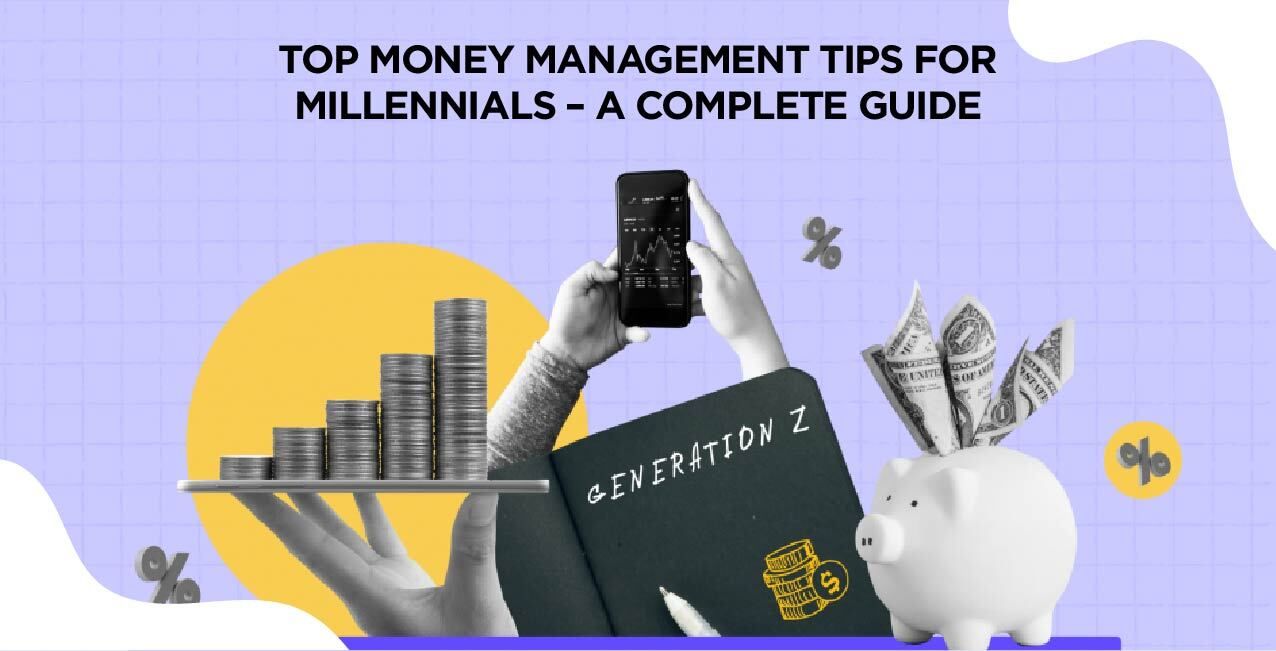
Author
LoansJagat Team
Read Time
7 Min
26 Mar 2025
Top Money Management Tips for Millennials – A Complete Guide
Ragini, a 30-year-old marketing consultant from Delhi, enjoyed weekend getaways, ordering food from Zomato, and late-night shopping outings. However, she faced a harsh reality when she checked her bank account on New Year's Day 2025.
- Salary Credited: ₹1,20,000
- Credit Card Bill: ₹90,000
- Rent and Bills: ₹35,000
- Savings? ₹5,000
With increasing costs and an uncertain freelance income, she realised she needed to make a change. Her mother's words kept ringing, "Paisa sambhal, warna paisa tujhe nachayega!"
Ragini preferred fixing her financial mess with these three simple steps:
Budgeting: She downloaded a budgeting app while keeping her spending capped at a very strict ₹50,000 per month.
Debt Management: In the first month, Ragini was able to pay off ₹30,000 from her credit card, saving her from high-interest charges.
Investment: Started a ₹5,000 per month SIP in mutual funds for financial security.
At the end of six months, her emergency fund amount increased to ₹60,000, and her credit card balance dropped to ₹20,000 as she started saving for a home loan.
Let's explore the best money management strategies ahead of 2025 because if Ragini can turn around her finances, so can you.
Budgeting: “Jeb Ka Hisaab Rakhna Zaroori Hai!”
A carefully thought-out budget is your financial security base for managing expenses properly, building consistent savings, and making strategic investments. The 50-30-20 budgeting rule is an efficient system for allocating economic resources through effective distribution strategies.
For example, if you have a monthly income of ₹1,00,000, it can be distributed using the following plan:
50% For Needs (₹50,000): Essential expenses like rent, groceries, electricity, internet, EMI payments, and insurance.
Expense Category | Amount |
Rent | ₹25,000 |
Groceries | ₹10,000 |
Utility Bills (Electricity, Water, Internet, Mobile) | ₹5,000 |
Loan/EMI Payments | ₹7,000 |
Insurance Premiums | ₹3,000 |
Total | ₹50,000 |
30% For Wants (₹30,000): Lifestyle expenses such as dining out, movies, travel, subscriptions, and shopping.
Expense Category | Amount |
Dining Out & Food Delivery | ₹8,000 |
Shopping (Clothes, Gadgets, Accessories) | ₹7,000 |
Entertainment (Netflix, Movies, Events) | ₹5,000 |
Travel & Weekend Getaways | ₹10,000 |
Total | ₹30,000 |
20% for Savings & Investments (₹20,000): This portion ensures financial security by establishing savings and investment plans.
Expense Category | Amount |
Emergency Fund | ₹5,000 |
SIPs in Mutual Funds | ₹7,000 |
Retirement Fund (PPF/NPS/EPF) | ₹5,000 |
Other Investments (Stocks, Gold, Real Estate) | ₹3,000 |
Total | ₹20,000 |
Emergency Fund: “Bure Waqt Ke Liye Taiyyari”
Financial crises are unexpected—loss of job, medical crisis, or sudden repairs. To develop financial stability, keep 3 to 6 months' worth of expenses in a liquid fund, such as savings accounts, fixed deposits, or liquid mutual funds.
How Much Should You Save?
If your monthly expenses are ₹50,000, your emergency fund should be managed as follows:
Savings Duration | Recommended Amount |
3 Months | ₹1,50,000 |
6 Months | ₹3,00,000 |
What Makes an Emergency Fund Necessary?
Avoid Debt Trap: Using credit cards or personal loans during emergencies exposes you to high interest rates of 24% to 36% annually.
Ready Access to Cash: You can withdraw cash from emergency funds without waiting as you would with stocks or investments held for the long term.
- These funds provide peace of mind since they eliminate the need to seek fast money or borrow from loans.
The Power of Compounding: “Mutual Fund Sahi Hai?”
Albert Einstein declared compound interest the world's eighth wonder, and this is true because of its remarkable properties. Investing for an extended period allows your money to increase exponentially.
How Does Compounding Work?
Your investment of ₹5,000 per month in an SIP with a 12% annual return will result in the following wealth accumulation:
Investment Duration | Total Invested | Estimated Returns | Final Amount |
5 Years | ₹3,00,000 | ₹1,02,000 | ₹4,02,000 |
10 Years | ₹6,00,000 | ₹6,65,000 | ₹12,65,000 |
15 Years | ₹9,00,000 | ₹20,40,000 | ₹29,40,000 |
20 Years | ₹12,00,000 | ₹38,90,000 | ₹50,90,000 |
Best Investment Options:
Equity Mutual Funds: Best for long-term wealth creation (5+ years). The most suitable investment funds consist of large-cap alongside mid-cap and ELSS funds for these purposes.
Index Funds: These investment products track the performance of Nifty 50 and Sensex.
PPF & NPS: Safe investments for retirement security, offering tax benefits and steady growth.
Investment Option | Minimum Investment | Recommended Duration | Expected Returns (Annual) | Maturity Amount (For ₹5,000/month SIP) |
Equity Mutual Funds | ₹500 to ₹1,000 | 5+ years | 12% to 15% | ₹50,00,000+ in 20 years |
Index Funds (Nifty 50, Sensex) | ₹500 to ₹5,000 | 10+ years | 10% to 12% | ₹40,00,000+ in 20 years |
PPF (Public Provident Fund) | ₹500 per month | 15 years (lock-in) | 7.1% (Fixed) | ₹22,00,000+ with ₹12,500/month |
NPS (National Pension System) | ₹500 per month | Until retirement (60 years) | 8% to 10% | ₹1,00,00,000+ with ₹5,000/month till 60 years |
Understanding UPI, Digital Payments & Fintech: “Cashless Economy Ka Zamana!”
India will transition to a cashless economy by 2025; thus, digital payments must become essential.
Ragini’s Digital Transformation
Ragini frequently failed to pay her bills and faced difficulties managing her expenses. She achieved the following benefits by using digital payments together with fintech applications:
- Setting up automatic payments through auto-pay for rent, electricity, and SIPs helps avoid late fees.
- Used UPI apps like PhonePe, Google Pay, and Paytm for quick transactions.
- Ragini began using Jupiter and Cred to track expenses, saving ₹5,000 from her monthly budget.
Key Digital Payment Essentials
- UPI Apps: Use PhonePe, Google Pay, or Paytm for instant and secure transfers.
- Auto-Pay: Automate bill payments, SIPs, and EMIs to avoid penalties.
- Fintech Apps: Apps like Cred, Jupiter, and Fi Money provide insights on spending and help save more.
“Zomato vs. Ghar Ka Khana” Cutting Down Unnecessary Expenses
Do you order food every day while using multiple OTT platforms? Your small daily expenses slowly reduce your savings without you realising it. A few strategic decisions will enable you to save thousands in monthly spending.
How Do Small Expenses Add Up?
Category | Monthly Cost | Yearly Cost |
Ordering food (₹300 x 20 days) | ₹6,000 | ₹72,000 |
OTT Subscriptions (Netflix, Prime, Hotstar, etc.) | ₹1,500 | ₹18,000 |
Unused Gym Membership | ₹2,000 | ₹24,000 |
Impulse Shopping (clothes, gadgets, etc.) | ₹5,000 | ₹60,000 |
Coffee/Tea from Cafes (₹100 x 30 days) | ₹3,000 | ₹36,000 |
Total Extra Spending | ₹17,500 | ₹2,10,000 |
Budgeting applications like Walnut and MoneyView enable users to track expenses, which helps them identify useless spending for elimination.
Investing the money you save by cutting ₹5000 from your monthly bill at ₹60,000 annually will accumulate to ₹15,00,000 to ₹20,00,000 through compounding over 20 years.
Investing In Gold, Stocks And Crypto: “Sona, Share, Ya Shiba Inu?”
Today's millennials have options for investment over traditional savings. The best among them to select would depend on risk tolerance, returns, and goals.
Comparison Of Investment Options
Investment Type | Minimum Investment | Risk Level | Expected Returns (Annual) | Liquidity | Example (₹5,000/month for 20 years) |
Gold ETFs & Digital Gold | ₹100 | Low | 6% to 8% | High | ₹19-22 lakhs (assuming 7% returns) |
Stocks & Mutual Funds | ₹500 to ₹5,000 | Medium to High | 10% to 15% | High | ₹50+ lakhs (assuming 12% returns) |
Cryptocurrency (Bitcoin, Ethereum, etc.) | ₹100 | Very High | Highly Volatile | High | ₹7+ crores (if Bitcoin had been bought at ₹20,000 in 2015) |
Debt Consolidation: “EMI Ke Jaal Se Niklo!”
Struggling with multiple loans? Combine your several outstanding debts into a new loan with a single monthly payment and a reduced interest rate to help you lower your financial stress.
Before vs. After Debt Consolidation
Loan Type | EMI | Interest Rate | Tenure | Total EMI Paid |
Personal Loan | ₹10,000 | 14% | 3 Years | ₹3,60,000 |
Credit Card Loan | ₹5,000 | 36% | 2 Years | ₹1,20,000 |
Car Loan | ₹7,000 | 12% | 4 Years | ₹3,36,000 |
Total (Before) | ₹22,000 | Varied | ₹8,16,000 | |
Consolidated Loan | ₹15,000 | 11% | 5 Years | ₹9,00,000 |
Insurance Is A Must: “Agar Ye Nahi Liya, Toh Kya Liya!”
Millennials often choose to avoid insurance, yet unexpected medical emergencies or sudden mishaps can quickly deplete all their savings. Your financial security stands firm when you have suitable coverage.
Must-Have Insurance Plans
- Health Insurance (₹10,00,000 to 15,00,000 coverage): Covers hospital bills, surgeries & medical costs.
- Term Insurance (₹1,00,00,000 policy): Ensures the family’s financial security in case of an emergency.
Tax Saving Hacks: “Jitna Kam Tax, Utna Zyada Paisa”
Through lawful tax deductions, people can effectively maximise their savings by lowering their tax obligations.
Top-Saving Options
Section | Deduction | Maximum Limit | Example Savings (For 30% Tax Bracket) |
80C | PPF, ELSS, Life Insurance, EPF | ₹1,50,000 | Save up to ₹45,000 |
80D | Health Insurance Premium | ₹25,000 (Self & Family) + ₹50,000 (Parents) | Save up to ₹22,500 |
HRA | House Rent Allowance | Based on salary & rent | Varies (₹60,000+ for metro cities) |
Home Loan | Interest on Home Loan (Section 24) | ₹2,00,000 | Save up to ₹60,000 |
Side Hustles And Passive Income: “9 To 5 Se Aage Bhi Duniya Hai!”
Relying on your job income alone is not wise. A helpful side hustle can give you extra money and secure your finances.
Side Hustle | Potential Earnings (per month) | Key Benefits |
Freelancing (Upwork, Fiverr) | ₹10,000 to ₹1,00,000+ | High demand for skills like writing, design, and coding |
Stock Market Trading | ₹5,000 to ₹50,000+ | Profits depend on market knowledge & strategy |
YouTube / Blogging | ₹10,000 to ₹5,00,000+ | Earnings from ads, sponsorships, and affiliate marketing |
Real Estate Rentals | ₹5,000 to ₹50,000+ | Passive income from property rentals |
Print-on-Demand Business | ₹10,000 to ₹1,00,000+ | Sell custom t-shirts and mugs via Etsy, Shopify, and Amazon |
Retirement Planning in Your 30s: "Abhi Se Sochna Padega"
Many millennials believe retirement planning is for later—but the earlier you start, the bigger your wealth.
Why Start Early?
- More time = higher compounding benefits
- Smaller investments grow into a large retirement corpus.
- Financial freedom at an early age.
Best Retirement Investment Options
NPS (National Pension Scheme): Provides tax benefits and a pension after retirement.
EPF (Employee Provident Fund): Employer-backed savings with guaranteed returns.
PPF (Public Provident Fund): A safe long-term investment with tax-free interest.
Example:
If Ragini starts a SIP of ₹10,000/month in an investment giving 12% annual returns, by the time she turns 60, her wealth can grow to:
At 10% return: ₹28,00,00,000
At 12% return: ₹39,00,00,000
Conclusion
Financial success is not about making more—it's about spending well, saving regularly, and investing wisely. As with Ragini, small but consistent steps can change your financial future.
Through smart budgeting, eliminating unnecessary expenses, debt consolidation, and strategic investments in mutual funds, NPS, and digital assets, millennials can achieve long-term financial independence. Furthermore, adopting fintech, UPI payments, and tax-saving tips guarantee maximum savings and minimum liabilities.
The key takeaway? Begin immediately. Whether it is ₹5,000 in SIPs, cancelling unwanted subscriptions, or creating an emergency fund, tiny moves today will translate into giant financial security tomorrow. Your future self will appreciate it!
FAQs
- How much should I save every month?
Save at least 20% of your income: boost this as your income increases.
- Is it a good time to invest in the stock market in 2025?
Yes, but invest in fundamentally sound companies or mutual funds rather than blindly riding the market.
- Should I use a personal loan for investment?
No. Loans are to be taken for requirements, not for investments. Excessive interest can offset your gains.
- How do I pay off credit card debt?
Apply the avalanche strategy (pay off the highest-interest debt first) or consolidate it into a low-interest personal loan.
- How do I invest in mutual funds?
Utilise apps like Groww, Zerodha, or Paytm Money—begin with a SIP in an index fund for risk-free returns.
About the Author

LoansJagat Team
‘Simplify Finance for Everyone.’ This is the common goal of our team, as we try to explain any topic with relatable examples. From personal to business finance, managing EMIs to becoming debt-free, we do extensive research on each and every parameter, so you don’t have to. Scroll up and have a look at what 15+ years of experience in the BFSI sector looks like.

Quick Apply Loan
Subscribe Now
Related Blog Post


